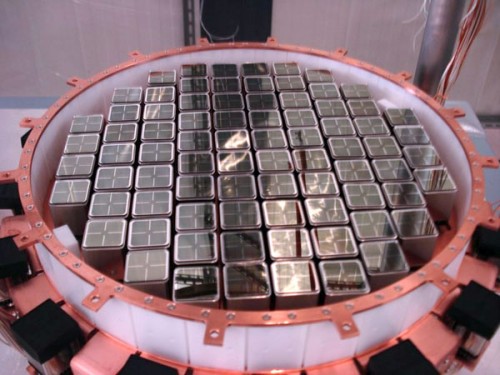
Part of the XENON100 experiment: does it agree with CDMS? (Courtesy: XENON)
By Hamish Johnston
A week or so ago the CDMS experiment in the US reported the detection of three possible dark-matter particles. While that might not sound like much, it is the best evidence yet that dark matter – mysterious stuff that appears to make up one quarter of the mass/energy of the universe – can be detected directly.
But as I said in an earlier blog entry, the detection further muddies the waters in terms of our understanding of exactly what dark matter is. Different experiments say very different things about its possible properties, and now a team of physicists in Denmark, the UK and Switzerland have uploaded a preprint on the arXiv server that tries to make sense of some of this speculation and contradiction.
The problem is primarily one of mass. The best estimate for the mass of the CDMS dark-matter particles is about 8.6 GeV/C2. This light-weight scenario seems to be backed up by somewhat weaker observations by the CoGeNT and CRESST-II experiments as well as the strong, yet controversial, signal in the DAMA detector.
On the other hand, the XENON experiment appears to have already ruled out dark matter at the CDMS mass and cross-section, the latter being a measure of how strongly it interacts with matter in a detector. Furthermore, another measurement by CDMS using a different detector also disagrees with a 8.6 GeV/C2 particle. In general, these experiments suggest a much more massive particle, which agrees with what many physicists expect based on theories that explain dark matter as weakly interacting massive particles (WIMPs). These tend to put the WIMP mass at somewhere between 100 and 1000 GeV/C2.
There are other theories, however, that put the dark-matter mass at about 5–10 GeV/C2, and it was such theories of light dark matter that motivated the CDMS discovery.
In the preprint, Mads Frandsen and colleagues argue that light dark matter could be compatible with both the XENON and CDMS results.To do this, the team first re-evaluated the XENON results – or more precisely the XENON10 and XENON100 results. XENON10 used 15 kg of liquid xenon located deep underground in Italy to search for dark matter in 2006–2007. XENON100 is currently using about 62 kg of the noble liquid and has published some preliminary results.
Frandsden and colleagues looked at a number of possible ways that the CDMS and XENON results could be reconciled. These included tweaks to the efficiencies of the detectors; assumptions about the speed at which dark-matter particles flow through the Earth; and modifications to the velocity dependence of how dark matter interacts with normal matter.
None of these strategies were able to reconcile the discrepancy, and so the team looked at a more radical approach – assuming that dark matter interacts less strongly with a heavy nucleus like xenon compared with a lighter nucleus such as the silicon used by CDMS.
One possibility involves the idea of “exothermic dark matter”, which is in an excited state that gives up internal energy when it collides with matter. Another is to assume that dark matter interacts differently with protons and neutrons – this could work because heavy nuclei have a higher neutron:proton ratio than their lighter counterparts.
The team concludes that the neutron/proton route is the most fruitful in terms of reconciling the two experiments – but as ever, they call for more data.
You can read the preprint here, and I’m guessing there will be more attempts at reconciliation to follow.
Dear Hamish, thanks for highlighting our work – however it isn’t quite true as you say that “None of these strategies (e.g. tweaks to the efficiencies of the detectors) were able to reconcile the discrepancy, and so the team looked at a more radical approach”. On the contrary, as emphasise in the Abstract: “While a previous result from the XENON10 experiment has supposedly ruled out such particles as dark matter, we fi nd by reanalysing the XENON10 data that this is not the case”. This is the *main* point of our work – more exotic explanations are not required at this stage. Of course the XENON10 collaboration needs to make a public statement concerning this important issue. More importantly, the XENON100 sensitivity is better and we are awaiting their new analysis eagerly!
Thanks for highlighting our work on your blog (http://blog.physicsworld.com/2013/04/25/are-cdms-and-xenon-both-right-about-dark-matter/).
However it isn’t quite true as you say that “None of these strategies (e.g. tweaks to the efficiencies of the detectors) were able to reconcile the discrepancy, and so the team looked at a more radical approach”. On the contrary, as we emphasise right in the Abstract (http://arxiv.org/abs/1304.6066):
“While a previous result from the XENON10 experiment has supposedly ruled out such particles as dark matter, we find by reanalysing the XENON10 data that this is not the case”.
This is the *main* point of our work – more exotic explanations are not required at this stage. Of course the XENON10 collaboration needs to make a public statement concerning this important issue. More importantly, the XENON100 sensitivity is better and we are awaiting their new analysis eagerly!
Prof Subir Sarkar,
Head, Particle Theory Group,
Rudolf Peierls Centre for Theoretical Physics,
University of Oxford,
Dear Hamish,
good read. But next time, why not pay attention to problems that cold dark matter – if it would exist – would have at the galactic level. Basically: the smaller the scale, the bigger the problems.
Trackback: LUX dark-matter search comes up empty | Micro Physics
Trackback: most sensitive direct DM detector comes online in fall